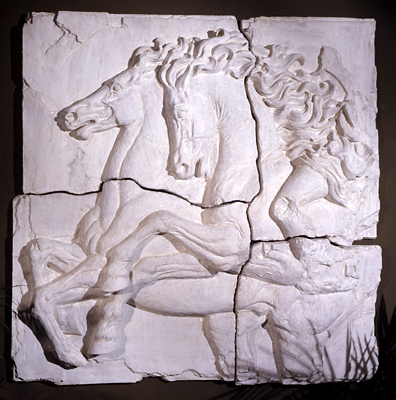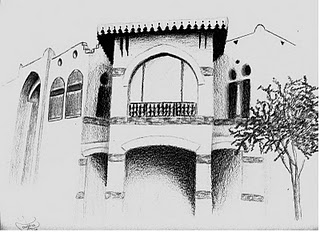The Architect

12.2.11 TME
return to
Educated Equestrian
return to
Educated Equestrian
Do you know how to build a house? Me either.
I’ve done plenty of remodeling. We have an old house and began nearly 15 years ago, room by room, to tear out the old plaster, lath, and what passed for electrical wiring in 1925 (two outlets in the entire upstairs, and lights with pull chains). Remodeling has involved window replacement, reinsulating, rewiring, and oh yeah, we thought it would be nice to duct some heat upstairs too. At the conclusion of a room remodel, everything gets a nice new coat of paint, some new fixtures (I shop for light fixtures with as much enthusiasm as some ladies shop for shoes) and new floorcovering. Looks and smells like a new house!
But the truth is, despite the cosmetic changes, and even the more functional changes we’ve made, it’s still an old house. The main foundation is rock and mortar, the additions, sturdy cement. Things have been patched together in way that can only make sense to the 1972 contractor. Whenever I get the urge to knock out a wall, my husband patiently explains which ones can go, and which are needed for support. In one case, I was adamant about the wall removal, so, the steel I-beams were ordered to support the upstairs in that part of the house. While I do understand the basic concept of gravity--if we do not support something correctly, it will fall--I have only a general idea of how to apply the laws of physics to house building. I am not familiar enough with building materials to decide what to use, and where, to safely construct a house that will stand the test of time, weather, and use, and still be pleasant to use and aesthetically pleasing. I relied on my husband, who happened to understand the pieces I did not.
I’ve done plenty of remodeling. We have an old house and began nearly 15 years ago, room by room, to tear out the old plaster, lath, and what passed for electrical wiring in 1925 (two outlets in the entire upstairs, and lights with pull chains). Remodeling has involved window replacement, reinsulating, rewiring, and oh yeah, we thought it would be nice to duct some heat upstairs too. At the conclusion of a room remodel, everything gets a nice new coat of paint, some new fixtures (I shop for light fixtures with as much enthusiasm as some ladies shop for shoes) and new floorcovering. Looks and smells like a new house!
But the truth is, despite the cosmetic changes, and even the more functional changes we’ve made, it’s still an old house. The main foundation is rock and mortar, the additions, sturdy cement. Things have been patched together in way that can only make sense to the 1972 contractor. Whenever I get the urge to knock out a wall, my husband patiently explains which ones can go, and which are needed for support. In one case, I was adamant about the wall removal, so, the steel I-beams were ordered to support the upstairs in that part of the house. While I do understand the basic concept of gravity--if we do not support something correctly, it will fall--I have only a general idea of how to apply the laws of physics to house building. I am not familiar enough with building materials to decide what to use, and where, to safely construct a house that will stand the test of time, weather, and use, and still be pleasant to use and aesthetically pleasing. I relied on my husband, who happened to understand the pieces I did not.

As a horse trainer, I cannot disregard the laws of nature, or only partially understand the nature of my subject. As a professional in this field, like an architect, I need to understand the construction of the horse, how he is supported, and how efficient locomotion may occur. My understanding needs to be more detailed than merely, that is the hock, there is the poll (I can, with accuracy, label “house parts”, windows and doors, but am still not quite ready to build one). I could study biology, learn the names of muscles, digestive organs, and how the nervous system functions (I’ve ready plenty
of electrical blueprints, and can draw up a mean sketch of where I want those lovely new light fixtures to be placed), but I also need to understand how they interact with one another. An educated trainer understands that the mental, emotional, and physical components of the horse can no more be separated than the components of a house. If you don’t have adequate heat, your pipes will freeze, rendering the toilet unusable; the plaster will crack and fall; and the environment might produce the emotional effect “glum” on the inhabitants, as they are cold and discouraged by their surroundings.
Studying the details of the horse has great advantages of course, but the educated equestrian understands the horse must be considered as a whole. The frame of the horse, like the frame of the house, supports the structure and all the functions that lie within, and no part of the horse (or house) can be considered at the exclusion of the other parts. I have a friend who habitually selects horses, with ewe necks, and long heavy heads. When I ask her why, she says, “It doesn’t matter to me, what the neck or head look like. I don’t ride the head.” This is erroneous thinking. Of course you are riding the neck and head. When one rides the horse, they are riding an entire horse, and every part of this horse is related to, and affects, every other part. A principle feature of structures of any kind, be it horses or houses, is that weight affects balance, and balance affects stability. Understanding the cause and effect relationship between these factors can allow a rider or trainer to use the horse’s natural weight distribution to its advantage. Understanding these factors can additionally help a trainer identify weaknesses in the horse’s structure, evaluate how a horse might naturally compensate for these weaknesses, and how to effectively teach a horse to compensate for these weaknesses in a safer, more beneficial manner than the horse would produce on its own. In all honesty, plenty of horses exist, whose confirmation produces a locomotive hardship. Additionally, this physical inadequacy causes mental and emotional distress, insecurity, as the horse is aware he is at a defensive disadvantage. His instinctual self understands the slowest, most clumsy horse in the herd is the one the wolves will get. Add the rider he is asked to carry, who is not necessarily independently well balanced, and he may struggle—even fail-- to compensate for the misfortune of having been created with disadvantageous proportions and asked to carry an unstable load. Our job, as riders and trainers is to assist him in finding the most efficient way to move, to maximize his athletic potential and ease his troubled mind.
A good architect considers the effects of all their design choices. With horses, breeders are the architects, and riders and trainers must make do with the results. The next time you set about building or “remodeling” a horse, take the time to educate yourself, so that you may build something that will stand the test of time, weather and use. Incidentally, if you follow functional guidelines, the product will naturally be pleasant to use and aesthetically pleasing. That is the marvel of true, pure classical design.
A good architect considers the effects of all their design choices. With horses, breeders are the architects, and riders and trainers must make do with the results. The next time you set about building or “remodeling” a horse, take the time to educate yourself, so that you may build something that will stand the test of time, weather and use. Incidentally, if you follow functional guidelines, the product will naturally be pleasant to use and aesthetically pleasing. That is the marvel of true, pure classical design.